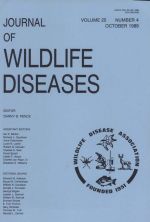A large, adult male polar bear (Ursus maritimus) was found dead on a barrier island north of Prudhoe Bay, Alaska (USA), in June 1987. There were no external signs of trauma. A twisted distended stomach, distinctive parenchymal and fascial congestion, and significant difficulty in repositioning the anterior abdominal organs, indicated that gastric dilatation-volvulus (GDV) was the proximate cause of death. Polar bears frequently consume large quantities of food at one time and have large stomachs that are well adapted to periodic gorging. The scarcity of food in winter and early spring, combined with voluntary fasting and protracted vigorous activity during the breeding season in late spring may have predisposed this bear to GDV. The relationship between GDV and postprandial exercise emphasizes the need for a better understanding of how the present human invasion of arctic habitats may influence polar bear activities.
How to translate text using browser tools
1 October 1989
Acute Gastric Dilatation and Volvulus in a Free-living Polar Bear
Steven C. Amstrup,
Carol A. Nielsen

Journal of Wildlife Diseases
Vol. 25 • No. 4
October 1989
Vol. 25 • No. 4
October 1989
case history
congestion
gastric dilatation
mortality
necropsy
polar bear
torsion




